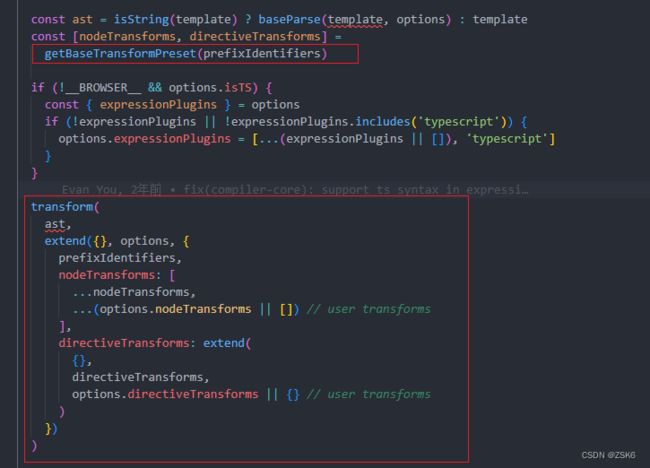【vue3】vue3源码探索之旅:compiler-core(一)
简言
compiler-core包是vue3源码代码编译的核心代码包,且与平台无关,这个包主要功能是将代码解析成ast、然后转换成codegenNode对象、再编译生成可执行代码(render渲染函数)。

compiler-core将沿着上面流程进行探索。
compiler-core
找到compiler-core/src/index.ts文件,可以看到它导出了baseCompile函数:
![]()
说明baseCompile是很重要的函数,它返回渲染函数。
然后进入改函数看代码:

看到了 baseParse函数、transform函数、generate函数,这个三个比较重要,将会围绕它们进行探索。
template解析
解析成ast的流程一般是词法分析+语法分析,然后解析实现代码由有限状态机模式实现,先逐个字符或片段进行词法分析,然后语法分析,得到ast树。
baseParse
template指的是有规则约束的代码字符串,compiler-core/src/parse.ts内的baseParse函数就是处理它的,返回ast树。
export function baseParse(
content: string,
options: ParserOptions = {}
): RootNode {
const context = createParserContext(content, options)
const start = getCursor(context)
return createRoot(
parseChildren(context, TextModes.DATA, []),
getSelection(context, start)
)
}
参数:
- content : template字符串
- options : 配置如何处理content字符串。
流程:
- createParserContext()函数,创建解析上下文context,这例存放源字符串、解析时的辅助信息和初始化配置。
- getCursor() : 获取当前读取位置信息。
- 创建根节点对象并返回,由createRoot()函数实现,根节点对象children属性存放的解析的上下文context的ast树啦。 由
createRoot(
parseChildren(context, TextModes.DATA, []),
getSelection(context, start)
)
实现。
示例:
const source = `
{{ world.burn() }}
yes
no
{{ value + index }}
`.trim();
const ast = baseParse(source);
console.log("ast:: ", ast);
结果:
ast:: {
type: 0,
children: [
{
type: 1,
ns: 0,
tag: 'div',
tagType: 0,
props: [Array],
isSelfClosing: false,
children: [Array],
loc: [Object],
codegenNode: undefined
}
],
helpers: Set(0) {},
components: [],
directives: [],
hoists: [],
imports: [],
cached: 0,
temps: 0,
codegenNode: undefined,
loc: {
start: { column: 1, line: 1, offset: 0 },
end: { column: 7, line: 6, offset: 196 },
source: '\n' +
' {{ world.burn() }}\n' +
' yes\n' +
' no\n' +
' {{ value + index }}\n' +
''
}
}
parseChildren
parseChildren函数是进行解析的函数,它是一个解析器,解析未知内容,然后给未知内容甄别打标签,分发给解析指定内容的函数处理返回节点树。整体以堆栈的形式解析成ast树。

例如 : 它发现在解析的是文本,就用parseText函数处理,发现是注释就用parseComment函数处理,发现是元素就用 parseElement函数处理,发现是文本插值语法就用parseInterpolation函数处理。
codegenNode
codegenNode是什么?得到ast树之后,然后进行转换这一步,这一步就是生成codegenNode的。因为ast树只是将模板字符串读取了出来,你还要进行处理,处理得到codeenNode,才能编译成渲染函数执行。

transform
transform是执行转换处理的函数。在此之前需要调用getBaseTransformPreset()函数获取各种转换处理函数和操作函数。

export function transform(root: RootNode, options: TransformOptions) {
const context = createTransformContext(root, options)
traverseNode(root, context)
if (options.hoistStatic) {
hoistStatic(root, context)
}
if (!options.ssr) {
createRootCodegen(root, context)
}
// finalize meta information
root.helpers = new Set([...context.helpers.keys()])
root.components = [...context.components]
root.directives = [...context.directives]
root.imports = context.imports
root.hoists = context.hoists
root.temps = context.temps
root.cached = context.cached
if (__COMPAT__) {
root.filters = [...context.filters!]
}
}
参数 :
- root , 从baseCompile函数看传的的ast树(baseParse返回的),
- options,转换配置信息。
流程 :
- createTransformContext函数生成转换上下文。
- traverseNode函数执行转换,各种转换就是在这调用执行的,指令啊,文本插值之类的。
- 若可以静态提升就执行hoistStatic函数
- 执行 createRootCodegen函数,在相应的ast树中生成codegenNode。
- 在根ast节点中绑定节点、指令、组件、静态提升信息、缓存等全局信息。
渲染函数
const source = `
{{ world.burn() }}
yes
no
{{ value + index }}
`.trim();
const render = baseCompile(source, {
sourceMap: true,
filename: `foo.vue`,
// mode: "module",
});
console.log(render);
generate
compiler-core/src/codegen.ts内的generate函数就是主要的生成渲染函数的地方。
export function generate(
ast: RootNode,
options: CodegenOptions & {
onContextCreated?: (context: CodegenContext) => void
} = {}
): CodegenResult {
const context = createCodegenContext(ast, options)
if (options.onContextCreated) options.onContextCreated(context)
const {
mode,
push,
prefixIdentifiers,
indent,
deindent,
newline,
scopeId,
ssr
} = context
const helpers = Array.from(ast.helpers)
const hasHelpers = helpers.length > 0
const useWithBlock = !prefixIdentifiers && mode !== 'module'
const genScopeId = !__BROWSER__ && scopeId != null && mode === 'module'
const isSetupInlined = !__BROWSER__ && !!options.inline
// preambles
// in setup() inline mode, the preamble is generated in a sub context
// and returned separately.
const preambleContext = isSetupInlined
? createCodegenContext(ast, options)
: context
if (!__BROWSER__ && mode === 'module') {
genModulePreamble(ast, preambleContext, genScopeId, isSetupInlined)
} else {
genFunctionPreamble(ast, preambleContext)
}
// enter render function
const functionName = ssr ? `ssrRender` : `render`
const args = ssr ? ['_ctx', '_push', '_parent', '_attrs'] : ['_ctx', '_cache']
if (!__BROWSER__ && options.bindingMetadata && !options.inline) {
// binding optimization args
args.push('$props', '$setup', '$data', '$options')
}
const signature =
!__BROWSER__ && options.isTS
? args.map(arg => `${arg}: any`).join(',')
: args.join(', ')
if (isSetupInlined) {
push(`(${signature}) => {`)
} else {
push(`function ${functionName}(${signature}) {`)
}
indent()
if (useWithBlock) {
push(`with (_ctx) {`)
indent()
// function mode const declarations should be inside with block
// also they should be renamed to avoid collision with user properties
if (hasHelpers) {
push(`const { ${helpers.map(aliasHelper).join(', ')} } = _Vue`)
push(`\n`)
newline()
}
}
// generate asset resolution statements
if (ast.components.length) {
genAssets(ast.components, 'component', context)
if (ast.directives.length || ast.temps > 0) {
newline()
}
}
if (ast.directives.length) {
genAssets(ast.directives, 'directive', context)
if (ast.temps > 0) {
newline()
}
}
if (__COMPAT__ && ast.filters && ast.filters.length) {
newline()
genAssets(ast.filters, 'filter', context)
newline()
}
if (ast.temps > 0) {
push(`let `)
for (let i = 0; i < ast.temps; i++) {
push(`${i > 0 ? `, ` : ``}_temp${i}`)
}
}
if (ast.components.length || ast.directives.length || ast.temps) {
push(`\n`)
newline()
}
// generate the VNode tree expression
if (!ssr) {
push(`return `)
}
if (ast.codegenNode) {
genNode(ast.codegenNode, context)
} else {
push(`null`)
}
if (useWithBlock) {
deindent()
push(`}`)
}
deindent()
push(`}`)
return {
ast,
code: context.code,
preamble: isSetupInlined ? preambleContext.code : ``,
// SourceMapGenerator does have toJSON() method but it's not in the types
map: context.map ? (context.map as any).toJSON() : undefined
}
}
参数:
- ast :转换后的ast树。
- options:编译时的配置。
流程:
- createCodegenContext函数创建代码生成上下文,包含配置信息和辅助操作函数。
- 根据编译模式(module或function)生成不同的渲染函数模板声明。
- 生成资产引用和优化
- 生成vnode表达式
- 返回包含ast、渲染函数、map映射信息、preamble信息的对象。
结语
compiler-core包的主要流程就是这样,是与平台无相关的实现解析编译vue模板的基础代码。


